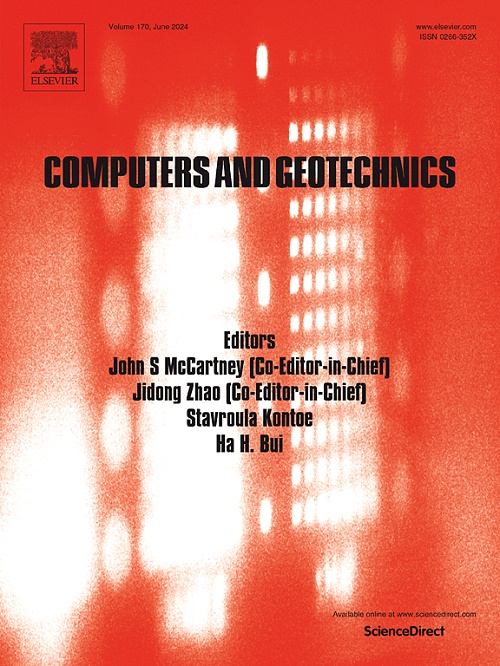电渗透过程中土壤裂缝的模拟
IF 5.3
1区 工程技术
Q1 COMPUTER SCIENCE, INTERDISCIPLINARY APPLICATIONS
引用次数: 0
摘要
电渗透是一种对细颗粒土壤的脱水技术,通过电流通过一系列电极,将大量孔隙水从阳极移动到阴极。脱水过程可以有效降低土壤含水量,但往往导致地表裂缝的形成。这些裂缝共同减少了电流的通过,从而降低了脱水效率。为了优化脱水,必须研究裂缝的形成。本文建立了电渗透脱水过程中土壤裂缝的数值预测模型。该模型考虑了非饱和土在脱水过程中的非饱和状态,并将非饱和土的本构面与莫尔-库仑破坏包络线相结合来确定裂缝。该模型还考虑了土体性质、饱和度和开裂程度的非线性变化。该模型与实验室测试结果进行了验证,并应用于各种实例问题。研究成果对裂缝演化进行了评价,并对影响裂缝发育的因素进行了识别。本文章由计算机程序翻译,如有差异,请以英文原文为准。
Modeling of soil cracks in electroosmosis
Electroosmosis is a dewatering technique for fine-grained soils that, by means of an electric current passing through a series of electrodes, moves a volume of pore water from the anodes toward the cathodes. The dewatering process can effectively reduce the soil water content but often results in the formation of surface cracks. The cracks collectively reduce the passage of the electric current, thereby diminishing the dewatering efficiency. To optimize dewatering, crack formation must be studied. A numerical model to predict soil cracks formed during the electroosmosis dewatering process is developed in this paper. This model considers the unsaturated conditions during dewatering and combines the constitutive surface of unsaturated soils with the Mohr–Coulomb failure envelope to determine cracking. This model also accounts for the nonlinear variations in soil properties, the degree of saturation, and cracking. This model is validated against laboratory test results and is applied to various example problems. The research outcomes result in the assessment of crack evolution and the identification of factors that affect crack development.
求助全文
通过发布文献求助,成功后即可免费获取论文全文。
去求助
来源期刊

Computers and Geotechnics
地学-地球科学综合
CiteScore
9.10
自引率
15.10%
发文量
438
审稿时长
45 days
期刊介绍:
The use of computers is firmly established in geotechnical engineering and continues to grow rapidly in both engineering practice and academe. The development of advanced numerical techniques and constitutive modeling, in conjunction with rapid developments in computer hardware, enables problems to be tackled that were unthinkable even a few years ago. Computers and Geotechnics provides an up-to-date reference for engineers and researchers engaged in computer aided analysis and research in geotechnical engineering. The journal is intended for an expeditious dissemination of advanced computer applications across a broad range of geotechnical topics. Contributions on advances in numerical algorithms, computer implementation of new constitutive models and probabilistic methods are especially encouraged.
 求助内容:
求助内容: 应助结果提醒方式:
应助结果提醒方式:


